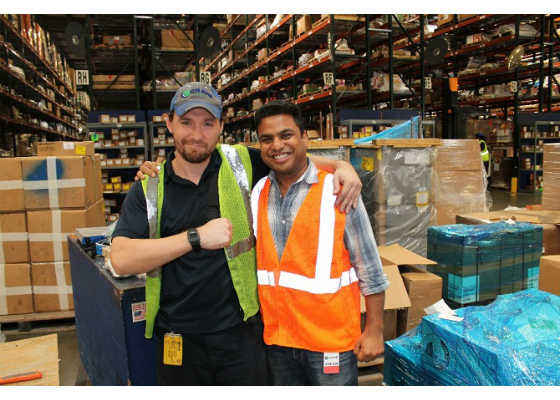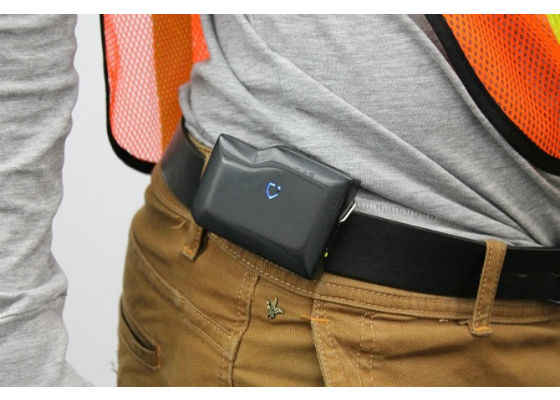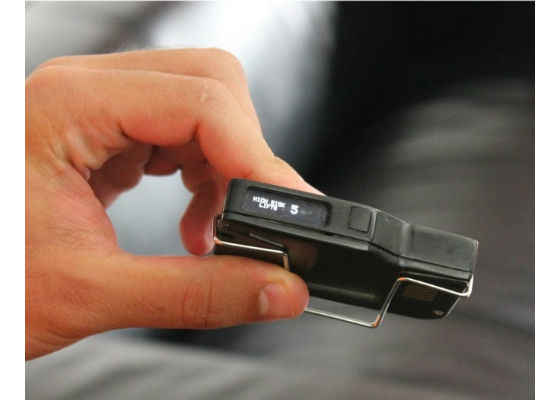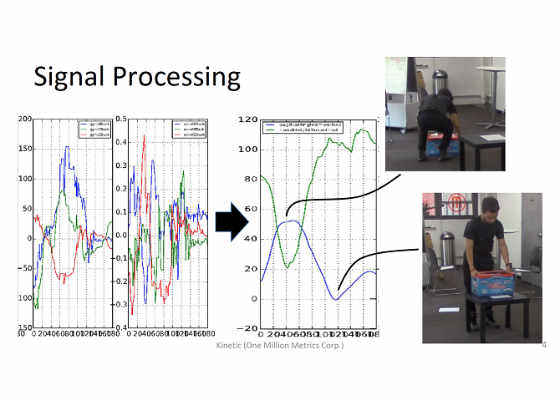KINETIC: Intel Edison Compute Module Powers Wearable Protection Against Lifting Injuries
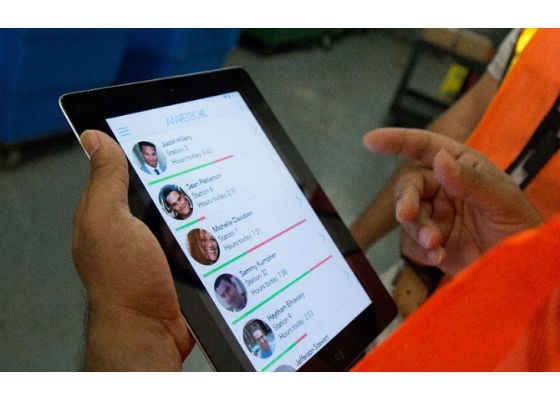
Heavy lifting is best handled with the legs. Or better yet, someone else’s legs. Regardless of who’s doing the work, lifting-related back injuries cost US companies a staggering $70bn USD in 20131. KINETIC, a smart wearables startup based in New York City, found a way to use Intel® Edison Compute Modules to create devices that can significantly reduce these costly workplace injuries.
Specifically, KINETIC uses sensors in a belt-mounted device along with sophisticated algorithms to detect whether a worker is lifting properly or in an unsafe manner. An optional wristband provides real-time feedback by vibrating to warn of a dangerous lift. To further train workers to be safe not sorry, at the end of a shift, the belt-worn devices are gathered and the data they collected is uploaded to the cloud where it is analyzed. The results are then turned into insights—statistics displayed on a Web-based dashboard. Those insights can be used to help train workers and even redesign the workplace to make it safer.
How did a small, one and a half-year-old startup quickly design, code, and bring an Industrial Internet of Things product to market? It’s a fascinating and inspiring story…
From the Beginning
Inspired by memories of his mother, who as a nurse repeatedly suffered painful back injuries when lifting patients, KINETIC cofounder and CEO Haytham Elhawary set out to reduce workplace injuries. Or as he put it, “take technology that’s been available to consumers for a long time and bring it to the workplace where it can be used to reduce work-related injuries.”
Thinking of warehouse workers as “industrial athletes,” Haytham took a cue from sports-related wearables such as Nike* Plus sensor-equipped shoes that detect motion, orientation, acceleration, and elevation to determine the activity being performed.
“As with any wearable or Internet of Things product,” he said, “there was a hardware component that required skills in manufacturing and engineering. Then we have a bunch of sensors that collect data. That requires skills for not just interpreting the data, but cleaning it to remove noise so we can make sense of it. And then there was the customer-facing side, which required designing a dashboard UX with intelligible analytics.”
To that end, he and his cofounder and CTO Aditya Bansal, an electrical engineer with experience in engineering consumer wearables, brought in a data scientist, a software engineer and two mechanical engineers, one whom has expertise in manufacturing. Haytham’s PhD is in Biomedical Engineering and Aditya’s PhD is in Electrical and Computer Engineering.
Enter the Intel® Edison Compute Module
The ability to collect data from workers and give them immediate feedback when they’re performing high-risk lifts meant the device needed to handle computations in real time.
“When you're in a warehouse or an industrial facility, typically, you collect data, send it to the cloud, do your heavy duty processing there, and then send it back to the worker for feedback,” Haytham said.
But there’s a problem with that hypothesis. WiFi* connectivity isn’t always available in warehouses and industrial facilities. The KINETIC team needed a solution capable of handling a lot of the heavy lifting processing locally, on the device, preferably in hardware. “Intel® Edison Compute Module made a lot of sense.” Haytham said. “Because it has an incredible amount of processing in a very small package, it provided real-time feedback to the worker locally, without relying on a WiFi connection.”
With integrated dual-band WiFi, Bluetooth* 4.0 support, a dual-core Atom processor, and an Intel® Quark microcontroller in a small form-factor and low-power package, Haytham felt, “This compute module gives us a great general-purpose platform that offers flexibility.” Flexibility to do what? “We’re currently focused on lifting injuries, because they account for the lion’s share of worker compensation claims. Moving forward, we want to be able to detect other types of worker activities and behaviors that can cause injuries.”
KINETIC’s wearable solutions rely on the Intel® Edison Compute Module to directly connect to their sensors, collect data, and store it locally in Flash memory. The device uses the module’s WiFi to upload data to the cloud, a task that takes place at the end of each working shift. Bluetooth will come into play when additional on-body sensors are added to the solution. Those sensors will communicate with the compute module through Bluetooth.
The Anatomy of KINETIC’s Devices
The KINETIC’s industrial wearable system includes two devices: a belt-worn sensor and analytics hub, and an optional sensor and display worn on the wrist. The wearables work in tandem to collect more comprehensive metrics about the worker.
Figure 1: KINETIC’s smart wearable devices protect workers backs by detecting potentially dangerous activities in real time.
The belt-worn device includes an integrated accelerometer and measures acceleration, angles, and orientation using proprietary algorithms. “What we’re measuring,” Haytham said, “are the things that move when a worker lifts something and places strain on the spine.”
Figure 2: KINETIC’s self-contained device includes sensors and an Intel® Edison Compute Module that clips onto a worker’s belt.
Modeling Activities
Haytham’s extensive background in bio-mechanics was key in developing the algorithms for detecting worker activities and determining when something is being done safely and when something isn’t.
“There’s a lot of literature to review,” Haytham said. “For the last 20 years, people have been developing and publishing models that describe the metrics that are good indicators of risk. We’ve been researching which metrics work best.”
Rather than reinvent the wheel, Haytham’s team automated it. “Traditionally, an ergonomist would come along and stop a worker in the middle of performing a task and literally start measuring how much their back was bending. How the knees bent. How far a box was from the lower back.”
While useful for research purposes, such manual methods aren’t practical in real-world, real-time situations. “For the first time, we can automate these things and if the risk is too high, provide real-time feedback.”
How do they calculate whether a box is being held too far away from a person’s body? “That’s where the optional wrist device come into play,” Haytham explained. “The belt-mounted device can look at how your back is moving and if you’re bending. We can do a lot of things with just a belt-mounted unit. If you want to get a more sophisticated, and know how far a box is from your lower back, or if you've lifted above shoulder height, which is considered high risk, then you need the wrist unit.”
Behavior Modification
A lot of thought went into the feedback mechanism used to signal danger. “Managers liked the idea of using electric shocks. The workers, not so much,” Haytham joked. “Seriously, we provide a vibration that’s similar to a phone vibrating when you get an SMS message. Ultimately, we want to change behavior.”
Adding to the challenge is the pressure of productivity. “Workers are trained to do certain tasks in a way that’s safe, but they often abandon that training in favor of doing what’s quickest.”
What KINETIC wants to do is remind workers of their training. Over the summer, they ran pilot programs at warehouses of shipping and logistics companies and learned some valuable lessons. “Feedback in general helps,” Haytham said. “To reinforce that feedback, you need to get workers engaged and motivated.”
Figure 3: The KINETIC device is thin enough to wear comfortably on a belt.
Older workers tend to buy into safety and health, whereas younger workers tend to be a little stronger and think they’re invincible. To motivate them all, KINETIC uses a method well-known among athletes—competition. “We keep track of the number of high-risk lifts each worker was doing per day and compare them against each other. The person with the most high-risk lifts performed safely gets a small reward.”
Borrowing another tactic from consumer wearables, KINETIC uses leader boards to let the workers see how they were doing compared to the previous day. “They gather around and start talking amongst themselves. ‘I can’t believe you’re beating me.’ ‘We’ve got to take her down.’ It stopped being a task and turned into something fun.”
Figure 4: Checking the leader board.
It also helped build trust. “When we share the leader board with workers, they’re seeing their daily numbers. They understand there’s nothing going on behind the scenes that they need to be concerned with.”
Data Handling
Sensors collect data, but they also collect extraneous noise. “The motion sensors pick up noise,” CTO Aditya Bansal told us. “We use many traditional signal-processing algorithms to clean up the signal. Edison’s processing power comes in quite handy for this.”
Figure 5: Sensor noise as plotted on the left makes it difficult to sort actual motion. After applying signal processing, the data clearly reveals the worker bending down (as the blue line rises) and coming to a standing position (as the blue line dips).
Worker action represents a second kind of noise. This type of noise occurs, for example, when a worker is having lunch, waving their hands, or doing something that isn’t lifting a box. “That comes back to what Haytham mentioned about data sensor algorithms and figuring out exactly what a worker was doing,” Aditya said. “We have to cancel out all the actions not related to the lifting action.”
To accomplish that, the KINETIC team records workers using video cameras. “We compare the workers motion data plot to what’s on video to figure out what they’re doing,” Aditya said.
Connecting to the Cloud
At the end of a shift, workers deposit their devices in a charging station. At the same time, all of the KINETIC devices begin pushing their data into the cloud. Amazon* Web Services (AWS) APIs are used to directly pass data from the devices to the cloud in a secure fashion.
Amazon* Elastic MapReduce (EMR) analytics process the vast amount of data collected from hundreds of workers in real time, storing it in a database hosted on AWS. KINETC’s dashboards pull data from that database to create meaningful metrics for the workforce managers.
Lessons Learned
With so much data to examine, it’s not surprising that KINETIC has seen some interesting patterns in worker behavior. “We see clear spikes at certain times of day,” Haytham said. “At one facility, just before lunch and again before they left for the day, we’d see an increase in bad posture. We think it reveals that they were trying to get a certain amount of work done before lunch and before leaving.”
“Imagine you’re a safety manager,” he continued. “You collect the number of high-risk lifts your workers are doing. Then you decide to incorporate a new training program, or spend money on some ergonomic equipment. You should see a change in that number of high-risk lifts. If you don't, then you know that what you've done doesn't have any impact. It allows you to quantify the impact of whatever program you've decided to roll out, which until now, you'd have to wait to see if the number of injuries went down or up to know if it was effective.”
Giving Back: Meetups
Both Haytham Elhawary and Aditya Bansal are involved in the developer community, incubating ideas, fostering emerging talent, and helping others bring their products to market. They do this by running monthly meetups in New York City.
“We talk about lessons learned, about getting a product to market and about building a brand. About manufacturing,” Haytham said. These events draw upwards of 200 people per month out of a community of some 3,000 developers on their members list. “I think it attests to the growth in hardware startups.”
Aditya agreed. “I run an embedded systems meet up here in New York City. It’s less focused on the business side. It's more about firmware and the technical community. A lot of companies present at the event, including Intel. It speaks to the size of the embedded community here in NYC.”
In Summary
Intel’s commitment to the IoT community is evident in the support they provide to companies interested in Intel® Edison technology. KINETIC is a case in point. Intel was instrumental in helping them quickly develop their wearable, cloud-connected smart devices and bringing them to market by answering technical questions and helping source parts. The Intel® Edison Compute Module was ideal at gathering and processing data locally and at securely sending it to the AWS cloud where it could be analyzed.
KINETIC actively contributes to the Intel® Developer Zone forums. “Wherever we have seen a problem and figured out a solution, we immediately post the answer.”
KINETIC is on a mission to increase worker safety, reduce costs, and in the process “protect the backbone of the economy.” In a space where hard hats, steel-toed boots, and safety goggles define “safety technology,” KINETIC is paving the way for IoT-driven solutions based on Intel® Edison Compute Modules, sensors, and AWS cloud services.
For more such intel IoT resources and tools from Intel, please visit the Intel® Developer Zone
Source: https://software.intel.com/en-us/articles/kinetic-intel-edison-compute-module-powers-wearable-protection-against-lifting-injuries

